Gloucester
Westgate Street
From
Westgate, the mouth of Berkeley Street opposite College Street
(which leads to the cathedral) has a printer's
trade sign painted on the once plain brick wall.
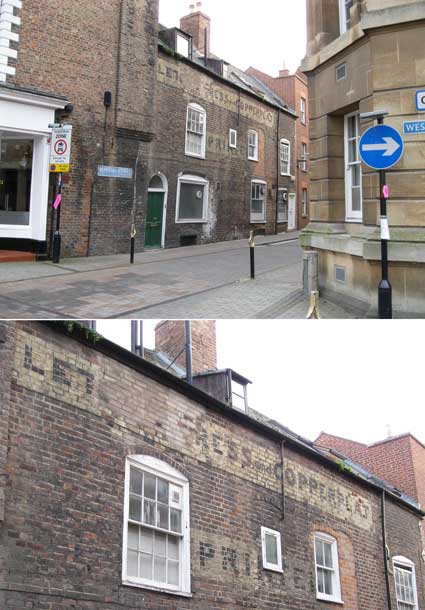 2013 images
2013 images
'LETTER PRESS
and COPPERPLAT[E]
PRINTER'
There is something odd
about this sign.
Firstly, the brickwork repair in different colour at the top left cover
most of the first word, however 'letterpress' as one word is the
conventional term for the printing process. The spacing here suggests
that the words beneath may have been 'letter' and 'press'. Secondly,
'Copperplate' is missing its final 'e', surely? Sitting within the the
long cartouche we seems to have 'Letter Press and Copperplat'. The
lower word is cut through by three windows, presumably added to the
building when it was converted from industrial to residential use.
A detail from the other direction shows that the 'E' is mainly still
there, although the cream background cartouch appears to have been
truncated:

Also in Westgate is this lettering and crest of Britannia high up:
'WHITE
LAMP
INN
BUIL[T] 1900'
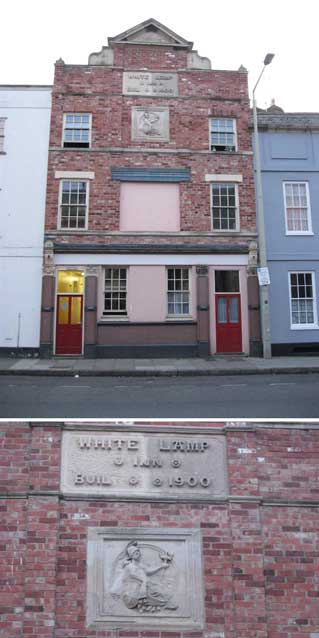
The White Lamp is shown at 45 Westgate Street in 1906 Kelly's
Directory. The address had changed to 87 Westgate Street in the
1939
Kelly's. It closed in the
nineteen seventies or eighties. Since closure
it was
left to slowly deteriorate and was held up by scaffolding for many
years. Trees grew within the fabric of the building and the roof had
collapsed. The facade of the old White Lamp, however, was still
impressive. In July 2002 work finally started to renovate the building.
The facade was retained in the development but this was probably
rebuilt.
Gloucester Docks
Gloucester Docks, the most inland port in the country.
The dock is locked from the River Severn and feeds at the other end
into Gloucester and Sharpness Canal. The area is an almost complete
example of a Victorian port with fifteen tall warehouses (all Listed)
and other dock-related buildings which have found new uses.
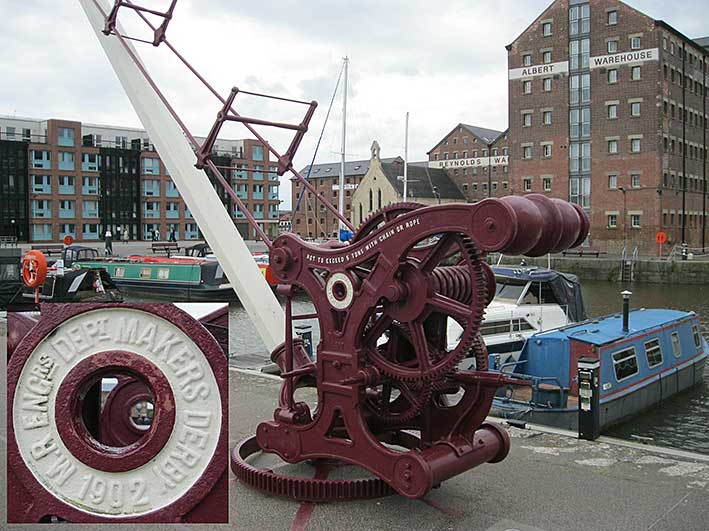 2016 images
2016 images
Restored, cleaned up and painted in maroon and white, this small
dockside crane has a range of lettering in the casting:
'NOT TO EXCEED 5 TONS WITH CHAIN OR
ROPE'
the serpentine warning following the curves of the cast iron
side, which is helpfully labelled 'LEFT' (not picked out in white)
below the triangular aperture.
The circular feature has the following running round the outer ring:
'M.R ENGRS DEPT
MAKERS DERBY 1902'
We haven't, so far,
confirmed the maker; however the Midland Railway had engineering works
in Derby, so perhaps this was designed as a railside crane.

In the background is one of the many warehouses 'ALBERT WAREHOUSE' to
the left and a modern replica to the right – both today converted for
accommodation.
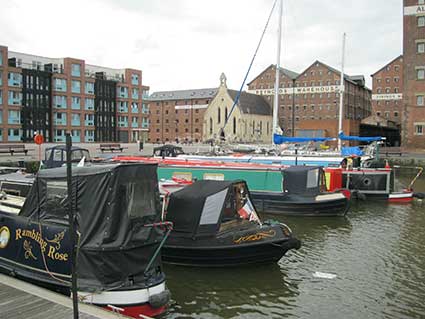
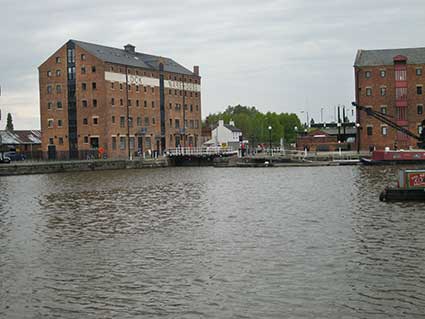
Above left: to the right of the modern block is 'SHIPTON WAREHOUSE',
the preserved Mariners Chapel, 'REYNOLDS WAREHOUSE', 'VININGS
WAREHOUSE'. Above right: 'LOCK WAREHOUSE', beside the lock linking the
dock to the River Severn. Narrow boats as well as leisure craft are
moored in the marina.
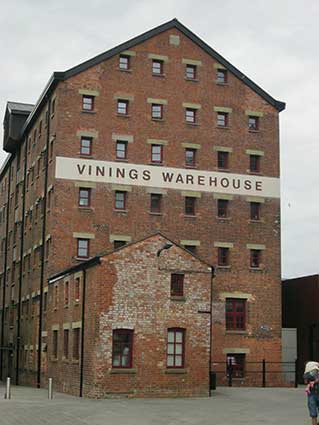
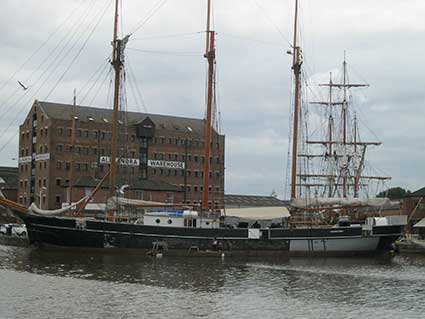
Above: 'VININGS WAREHOUSE' and 'ALEXANDRA WAREHOUSE' show that almost
all the original lettering on the dockside structures has been
repainted, sadly, but understandably. Whether old, weathered signs
should be painted over is a moot point. In many cases, leaving the sign
alone is the best way to save it (see the 'Edward
Fison Ltd' sign on Ipswich New Cut which has become clearer with
weathering over the years).
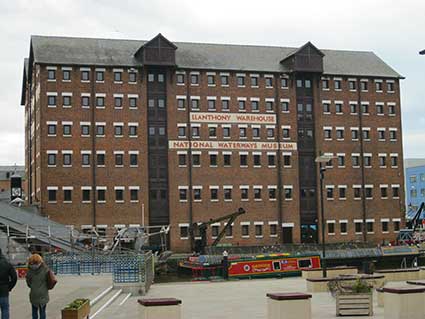
Above: the original 'LLANTHONY WAREHOUSE' sign in red characters has
been joined by the new drop-shadow red caps of 'NATIONAL WATERWAYS
MUSEUM'. See below under 'Mariners Ale' for an explanation of
'Llanthony'.
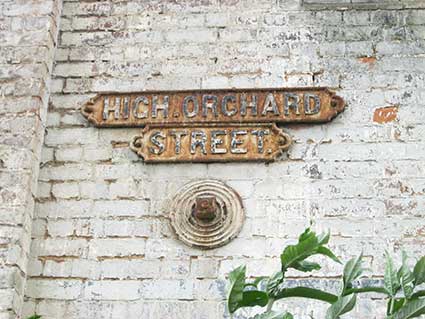
Below: the conversion of industrial to leisure/retail use is typified
by this view of a preserved bridge between warehouses, one of which has
the repainted '[MA]THEWS & CO LTD' sign. High Orchard Street, which
has a restored pair of street nameplates with white capitals on black:
'HIGH ORCHARD' 'STREET' to the left, is now a pedestrian walk with
shops and businesses on each side.
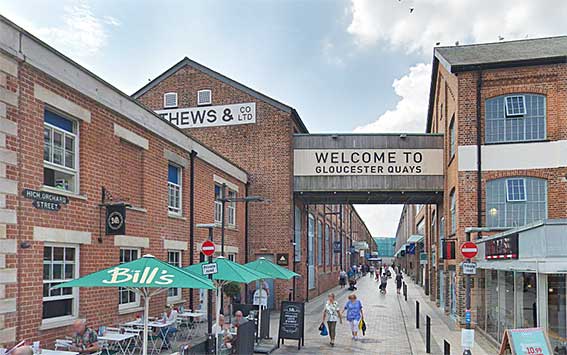 2018 image
2018 image
Below: a typical repurposed industrial building which bears the
original date plaque: '1913'. Perhaps the
surrounding finish leaves something to
be desired.
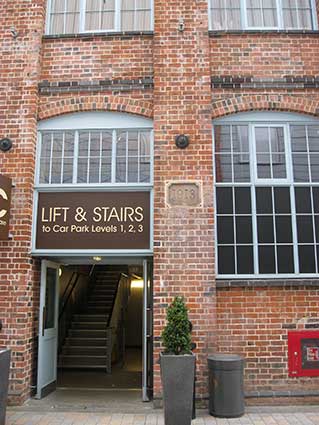
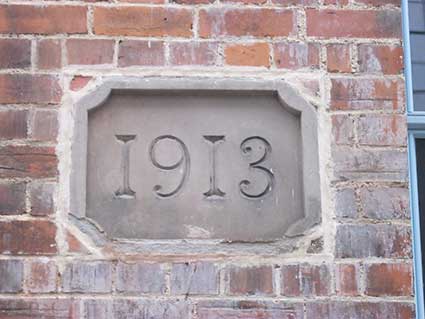 2016
images
2016
images
Below: the partially demolished warehouse shows the vestigial
painted sign: 'GLOU[?] ... LTD[?]'; the
parts
have been preserved by the building of later pitched roof structures,
now gone.
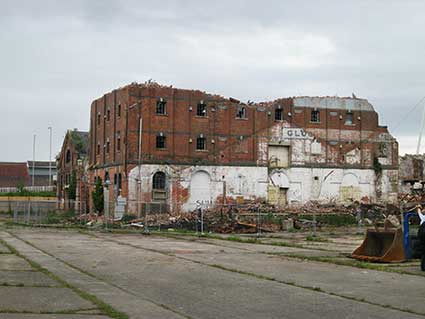
G. & W.E. Downing, Maltster,
Merchants Road
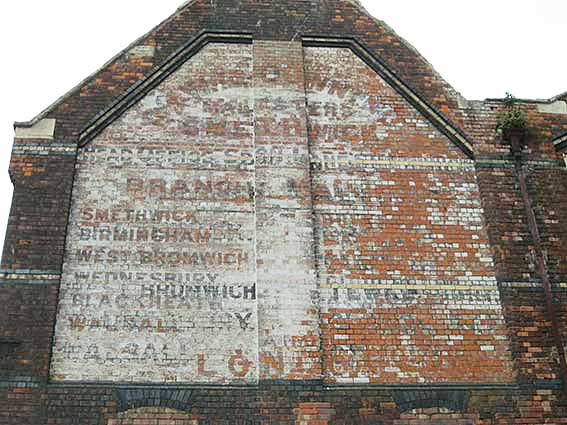
Thanks to scale model-maker, Peter Johnson, we can give the full
decoding of this multi-layered, fugitive lettering:
‘G & WE DOWNING
MALSTERS
SMETHWICK
HEAD OFFICE SPON LANE SMETHWICK
BRANCH MALTINGS
————
BIRMINGHAM LIVERPOOL
HULL GLASGOW
DUNDEE BRISTOL
NEWPORT IPSWICH
WEST BROMWICH TEWKESBURY
WEDNESBURY GLOUCESTER
WALSALL OXFORD’
[with a fading 'LONDON' below]
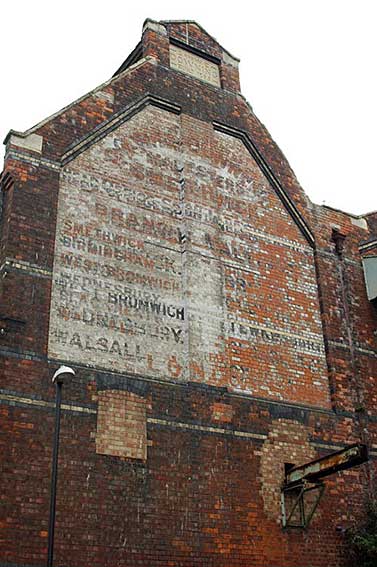
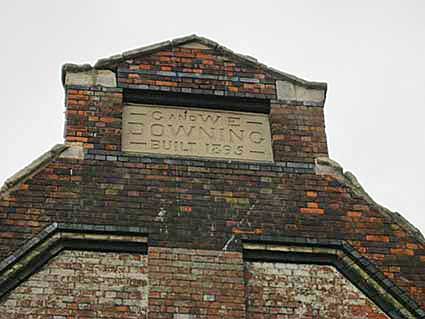
The panel at the very top reads:
‘– G AND WE –
DOWNING
– BUILT1895’ –
The '8' has the flattened top and
the '5' is rather sloping.
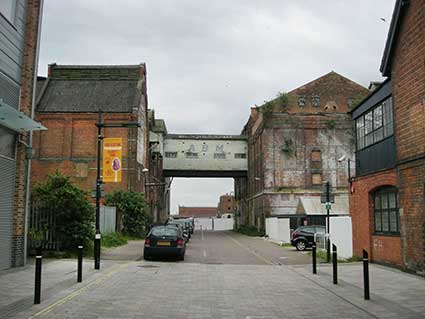
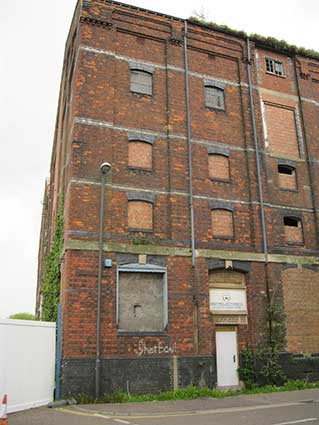
Above
left: the Downing lettering in Merchants Road can be seen at centre
left; the office entrance is at the far end of the building at centre
right. The bridge between the two, here lettered 'ABM' , has now been
removed. Associated British Maltsters (ABM MALT) must have bought the
Downing business, perhaps with other steps in between. Following
extensive modernisations of the malting process in the 1950s, in the
1970s the site began trading under the name Associated British
Maltsters, a group that the Downing's business had joined back in 1931.
Eventually, the business at Gloucester could no longer compete, and it
closed down around 1980. The buildings were later used by West Midlands
Farmers for grain storage.
Above right: the building with the office entrance and street nameplate
(behind the lamp-post).
Below: a 'MERCHANTS ROAD' cast iron street nameplate in
original, unrepainted condition. This is sited to the left of the
office
entrance shown below. Direct railway communication was provided by a
siding from the Midland Railway running along Merchants Road.
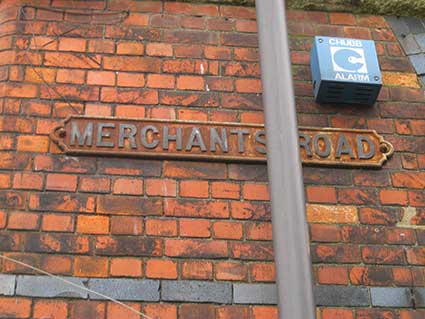
'Maltsters George and William E. Downing
from Smethwick in the
West Midlands opened their first malthouse in Gloucester in 1876. As
their business expanded, they built a second malthouse to the north of
the original building in 1895. Designed by Walter B. Wood and built by
the Gurney Brothers, it consisted of three ranges. The first two
included a basement with a steeping tank in which barley was soaked
usually for a couple of days and a working floor where the barley was
allowed to germinate and sprout, a malt room where malt was stored and
bagged, two more working floors, and an attic where barley was stored.
The third range, to the north included a large malt kiln and a smaller
barley kiln, where germination was inhibited. Part of this building was
also used to clean and repair returned malt sacks. The absence of
windows on the upper floors of the third range gave Downing ample space
to advertise their business.'
[Information from:
http://paintedsignsandmosaics.blogspot.com/2010/09/g-w-e-downing-maltsters-gloucester-1.html]
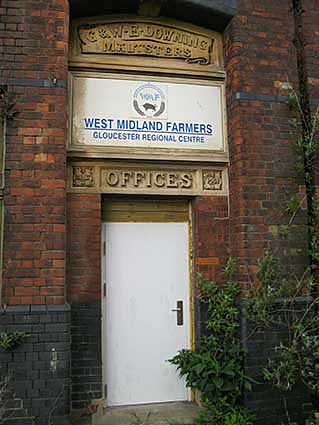
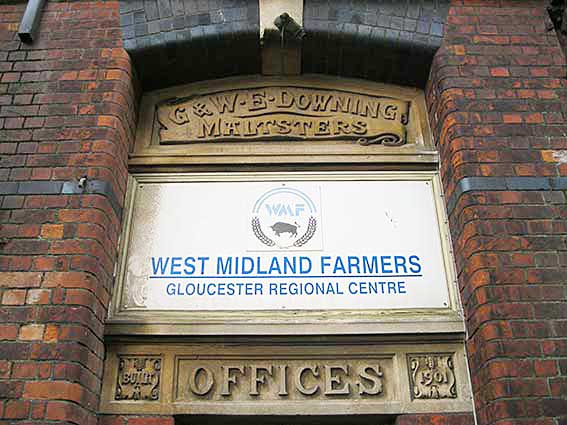
‘G. & W.E. DOWNING
MALTSTER
OFFICES
BUILT … 1901’
The upper lettering curves and
flows over a rather nice banner with the ends curling: a nice piece of
carving. The letterforms are quite decorative to match.
British Waterways Board, dock
drinking fountain
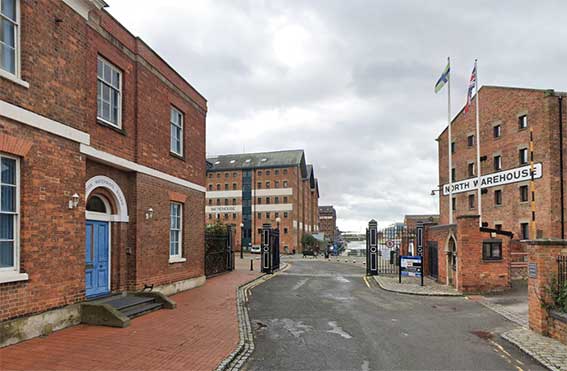 2018
images
2018
images
The British Waterways Board was initially established as a result of
the Transport Act, 1962 and took control of the inland waterways assets
of the British Transport Commission in 1963. In 2012 all of British
Waterways' assets and responsibilities in England and Wales were
transferred to the newly founded charity the Canal & River Trust.
In Scotland, British Waterways continues to operate as a standalone
public corporation under the trading name Scottish Canals.
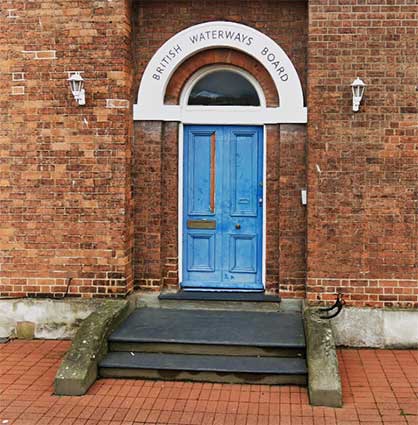
Below: an unusual drinking fountain is located at the north gate of
Gloucester Docks; it was installed by the Gloucester City Board of
Health at the bequest of merchants on behalf of their workers in 1863.
This water supply was also used to fill ships’ water casks. A stuccoed
arch with bull nosed-moulding adhered to the brick wall serves as a
mount for the cast iron drinking fountain consisting of two pieces. A
cast iron back-plate with Romanesque arch has an inscription on the
trough at street level. A small
hydrant to the right is mounted off the ground. There is no visible tap
or marking to identify the manufacturer of this structure. The fountain
is Listed Grade II.

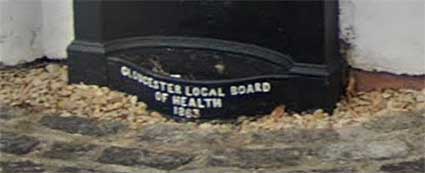
‘GLOUCESTER LOCAL BOARD
OF HEALTH
1863’
Below: the drinking fountain in front of ‘NORTH WAREHOUSE’.
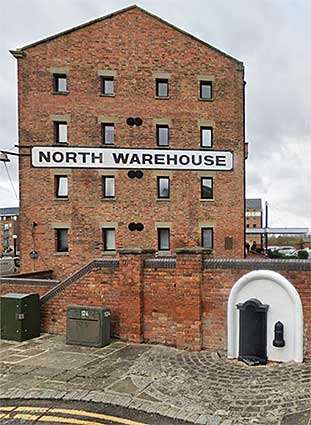
Mariners Ale, 1 Llanthony
Road
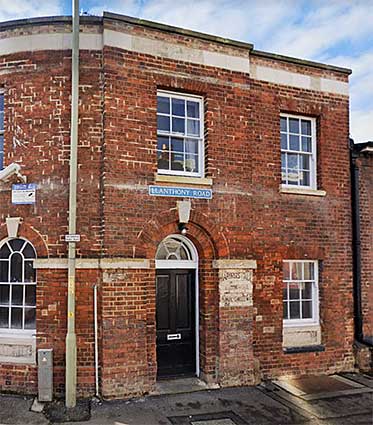
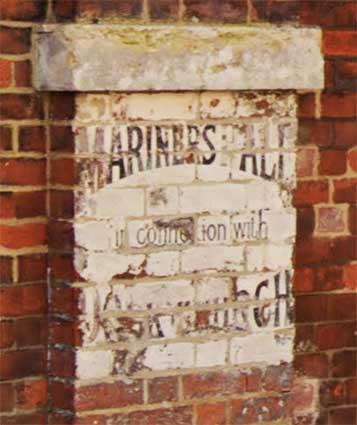 2020
image
2020
image
'MARINERS ALE
in conjunction with
DOCK CHURCH[?]'
One assumes that this building
curving off Southgate Street was once a social club or public house. So
far we haven't been able to pin down whether this ale was brewed
locally.
Incidentally, the street name comes from the Llanthony Secunda Priory,
a house of Augustinian canons in the parish of Hempsted,
Gloucestershire situated about half a mile south-west of Gloucester
Castle in the City of Gloucester. It was founded in 1136.
[UPDATE: 'In researching some
of our local ghost signs I found myself back in your website at the
entry for 1 Llanthony Road. I’m afraid that your reference
to Mariners Ale might have been a bit of wishful thinking.
The sign is near one of the entrances to Mariners Hall – the other
being in Church Street. The Hall was established in conjunction
with the Mariners Chapel in Gloucester Docks and is still in use as a
meeting room and church office, The sign should read
'MARINERS HALL
In connection with
DOCK CHURCH'
It is surprising that the sign has survived at all because up until
2019 the pillars either side of the door were completely painted over.
Kind regards, Mike Payne.'
The Goat Inn, 71-72
Llanthony Road
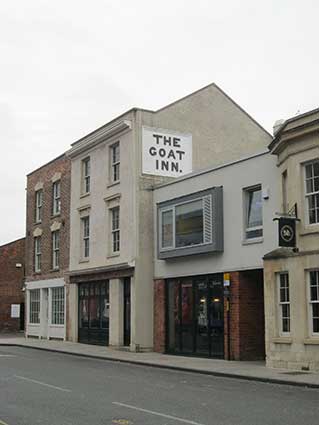
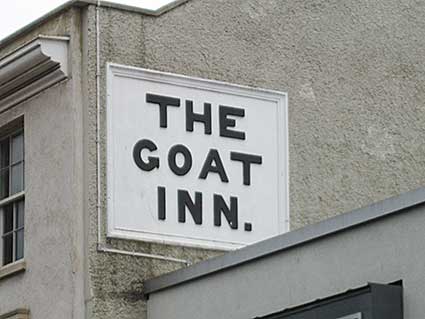
‘THE
GOAT
INN.’
Thank goodness they included that
huge square full-stop in relief and surrounded the whole thing in a
triple frame to draw attention to it. The letterform could be described
as 'vernacular'.
The Black Swan Hotel, 68
and 70 Southgate Street, corner with Commercial Road
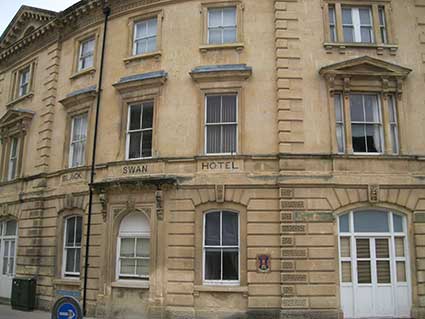 2018 images
2018 images
'BLACK SWAN HOTEL'
is lettered on the stone above ground florr level; painted
boards used to cover this sign. Built in 1849-50, this building is
Listed Grade II.
Ghost signs on either side of doorway on Southgate Street for some
reason say:
‘GO BY ROAD’
‘SEND BY ROAD’
It also features a locally familiar ‘West Country Ales, 1760,
Best in the West’ ceramic sign. West Country Breweries Ltd, 256 High
Street, Cheltenham, Gloucestershire. Registered 15th April 1888 as the
Cheltenham Original Brewery Co. Ltd to acquire the business of J.T.
Agg-Gardner founded in 1760. Name changed to Cheltenham & Hereford
Breweries Ltd. 1945 when the Hereford & Tredegar Brewery Ltd. was
acquired and was later renamed again to Cheltenham Brewery Holdings
Ltd. Merged with the Stroud Brewery Co. Ltd. 1958 to form West Country
Breweries Ltd. with 1,275 tied houses. Acquired by Whitbread & Co.
Ltd. 1963 and was known as Whitbread Flowers Ltd. Closed 1998 and some
buildings were demolished in 2004. The site around the original tower
brewery building is now a modern shopping centre: ‘The Brewery Quarter’
between High Street and St Margarets Road, Cheltenham.
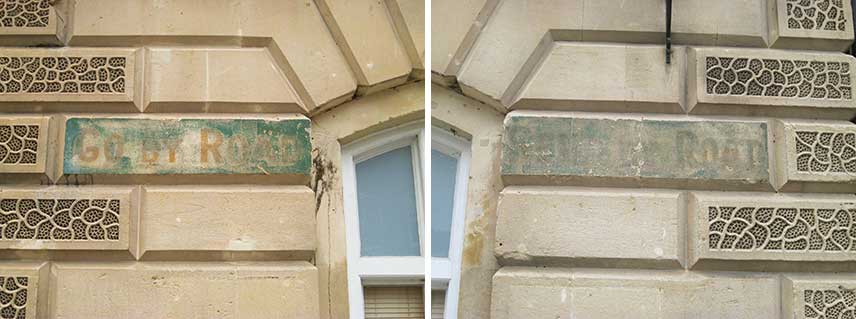
Dawes, House Decorator, 13
Park Road
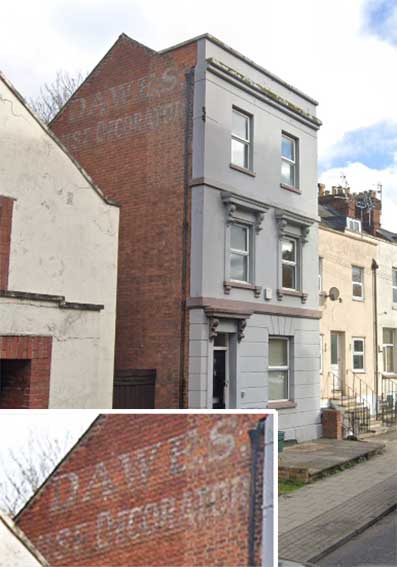
‘DAWES.
HOUSE DECORATOR’
is painted in serif'd capitals very high up on the side wall of
the house. The second and third words are very condensed to fit the
space.
G.A. Baker & Son, Jeweller,
5 Southgate Street
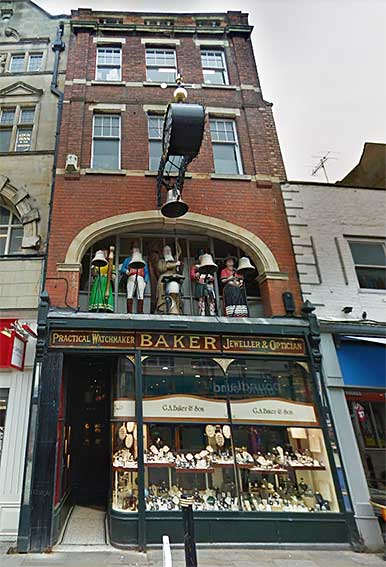
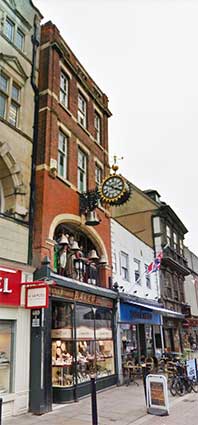
‘PRACTICAL WATCHMAKER ... BAKER
... JEWELLER & OPTICIAN'
"The Mann family has been retailing on the Cross in Gloucester
since 1741. For over 250 years and 8 generations the family supplied
jewellery and time pieces to the county and in 1901 became watchmakers
to the Admiralty. In 1862, the then owner, William Mann was appointed
Sheriff of the city of Gloucester. The iconic G. A. Baker building in
Southgate Street with its original and unique Turret Clock is the Head
Office of the Cotswold Fine Jewellery Group." Automaton clock: the
figures striking the quarter hours and the chimes represent the
constituent countries of the United Kingdom; left to right: Northern
Ireland, England, Scotland and Wales. In the centre is Old Father Time,
who strikes the hours.
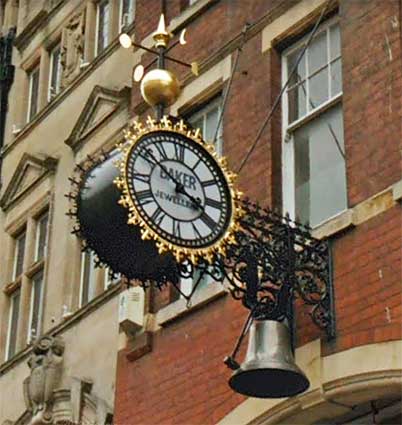
Powell, Lane Manufacturing Company,
Severn Road
 2021 image courtesy Louisa Gaylard
2021 image courtesy Louisa Gaylard 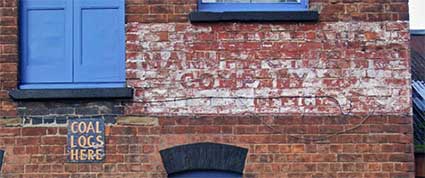
'POWELL, LANE
MANUFACTURING
COMPANY LTD
OFFICES'
'COAL
LOGS
HERE'
The latter sign, yellow caps on a
blue panel, presumably directs fuel delivery drivers to the first floor
loading door – one assumes that the paper manufacturers used machinery
powered by a steam engine.
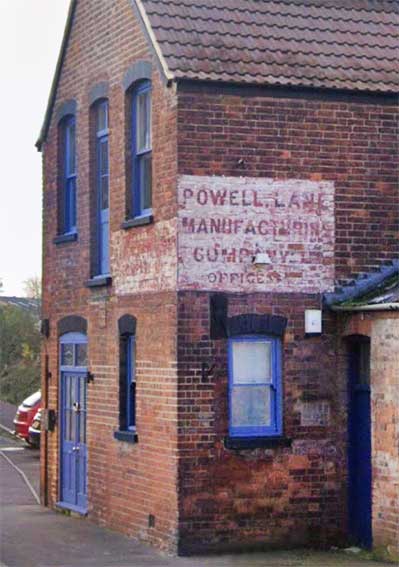 2018
images
2018
images
Moving down to the gable end of the third building on this site, we can
make out that the Powell, Lane company traded from all of them.
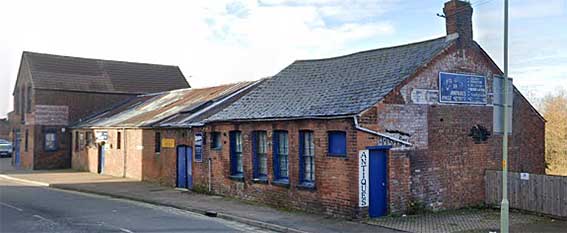
Grace's Guide (see Links) shows a period advertisement for the
company which locates the works at 'Severn Side Wharf': 'Manufacturers
of
PAPER SHAVING, Corrugated and Wave Embossed Parchments and Paper
Requisites for Biscuits and Confectionery Packings, WAXED PAPERS.' A
London office is shown at Blackfriars House, New Bridge Street, E.C.4;
this may just have been the registered office.
Albert E. Reed & Co. (established 1894) began, in 1928,
to supply straw paper to Powell, Lane Manufacturing Co.
of Gloucester to make corrugated paper. In 1930 Reed acquired the
factory that Powell Lane had established at Tovil Mill in Kent and
formed the Medway Corrugated Paper Co. and established a case-making
plant next to the mill at Aylesford. By 1944 Reed's had acquired
Powell, Lane Manufacturing Co. Remarkably, the parent company evolved
into Reed Paper Group, later the massive Reed International publishing
and information businesses.
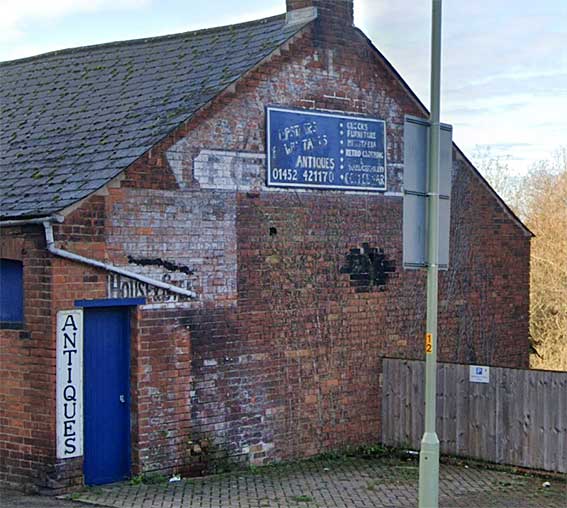
The gable sign is, to say the least, fugitive. At the top,
the curving lettering 'POLWELL LANE' can be made out; the word 'MA
-nufacturing' disappears behind a blue metal sign advertising a more
recent antiques business. Lower still is a white cartouche outlined in
black bearing, we think, 'F CE...'. A white rectangle at the left
probably once bore a sign (now unreadable) and the lower part has the
words in condensed large-and-small-capitals: 'HOUSE & STEA...[?]',
now obscured by a downpipe and cut into by the door lintel.
Talbots Bottlers, Ladybellegate
Street

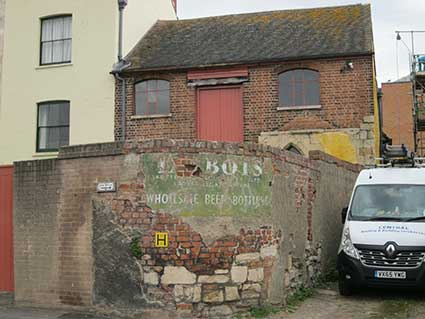 2016
images
2016
images
‘TALBOTS
BOTTLERS (GLOUCESTER) LTD.
LADYBELLEGATE STREET
WHOLESALE BEER BOTTLERS’
This sign of white characters on a green ground is on the
crumbling rendering close to the junction of Ladybellegate Street and
Commercial Road. Thomas Talbot (1819-1891) founded the Talbot Mineral
Water Company in 1845. The firm had premises in Ladybellegate Street
from at least 1867 and occupied some of the buildings of the former
Blackfriars monastery (note the top of a Gothic stone arch, above
right) and built some new structures along Commercial
Road. In 1873 the firm also had premises at 48 Northgate Street. It
later became Talbot Bottlers (Gloucester) Limited. Apart from mineral
water, the firm produced seltzer water, potass water, lemonade, soda
water, ginger ale, magnesia water, aerated lime juice, lithia water
(with lithium salts), quinine tonic water and orange champagne. Later
they began to bottle alcoholic drinks, including beer and cider for
Bass and Worthington. In 1886, Talbot was elected high sheriff of
Gloucester and later became an alderman of the city.
Oddly, the same company name and type of trade once thrived in Ipswich:
the unrelated Messers
Talbot and Co. Ltd., Mineral Water Manufacturers. Our Unicorn Brewery page gives much more
information.
Public Library, Brunswick Road
 2018 images
2018 images
'PUBLIC LIBRARY ... 1900'
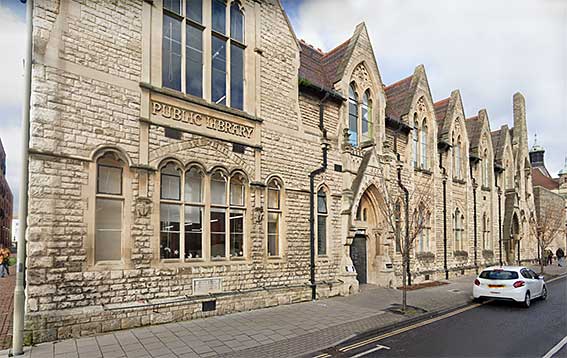
First called the Schools of Science and Art, the original part of
the building was designed by local architects Fulljames, Waller &
Son in 1872 for the Gloucester Science and Art Society which was mainly
funded by subscribers. It also housed a museum of Literature and
Science. There were several failed attempts to run a free public
library at the Working Men's Institute and a survey from 1887 shows
that taxpayers voted against having a free public library. In 1893, the
building was extended with a hall built for the Gloucester Science and
Art Society called the Price Memorial Hall. The city corporation
brought the book collection of the Gloucester Literary and Scientific
Association in 1895 and took over the buildings and running of the
school and museum in 1896. In 1897 a free library service was started.
The building was extended to the south in 1900 to house the new
library, which was built to mark Queen Victoria's Diamond Jubilee and
designed by F.W Waller. In 1902, the Price Memorial Hall was converted
to be used as part of the museum which became The Museum of Gloucester.
The Neo-Gothic building is Listed Grade II.
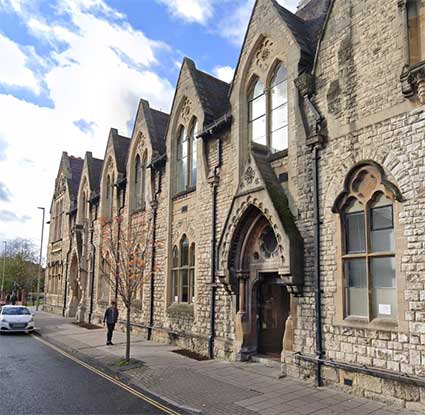
Monument House, St Marys
Square
The name runs over the decorative porch. This fine town
house, dates to around 1770, but may incorporate an earlier structure.
It
has three stroreys, a cellar and attic rooms. and is Listed Grade II.
The Listing text goes to town in relation to the entrance: 'In the
third bay from the left a narrow, recessed entrance porch with basket
arch is framed by stone pilasters and an applied, Gothick style,
crocketted ogee arch with a foliated finial above; framing the top of
the arch and finial a stepped cornice on brackets arched in the centre
above the finial; inside the porch five stone steps to the doorway
threshold, six-panel door with the four, fielded, upper panels and
basket-arched fanlight with radiating glazing bars.'
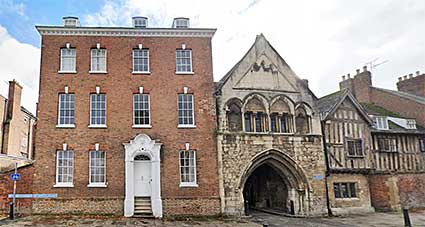
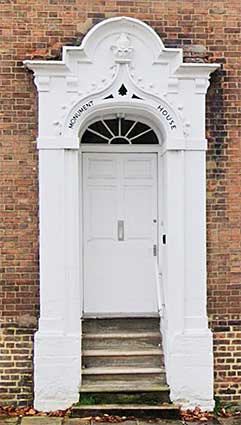
Above: the fine rake of buildings on the east side of St Marys Square.
To the rightof Monument House is the ancient St Mary's Gate which is
Listed Grade I. This was originally built in the late 12th century (and
refronted and heightened in early 13th century) for the Benedictine
Abbey of St Peter as the Great Gate to the Outer Court of the
monastery, now part of College Green. It was altered in the 18th
century
and was restored in late 19th by F.S. Waller for the Dean and Chapter
of
the Cathedral. The gate passage leads from St Marys Square into the
north-west corner of College Green. Although not visible in the above
photograph, the cathedral lies not far behind Monument House
and the gateway.
Shop '1450', 66
Westgate Street
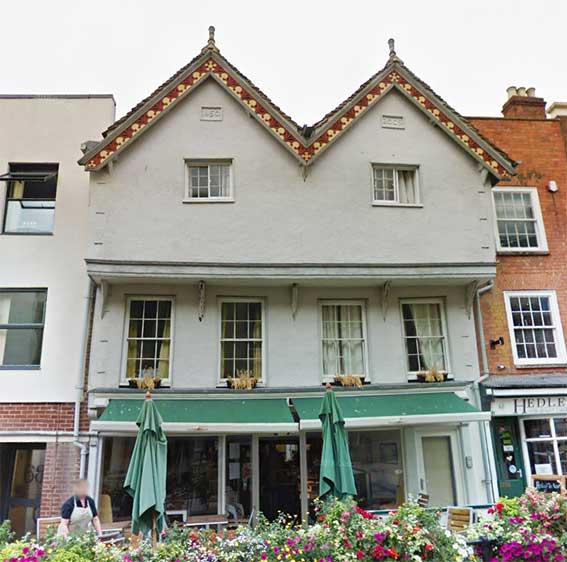
The panels at the top of the gables read:
'1450' '2009'
The facade is jettied above the
ground level 19th century shop front; then again above the first floor
level. Thae gables have nicely painted barge boards. This
timber-framed, 15th century merchant's house is Listed Grade
II*.
Boselli's Ice Cream, on the
side wall of 58 St
Oswalds Road
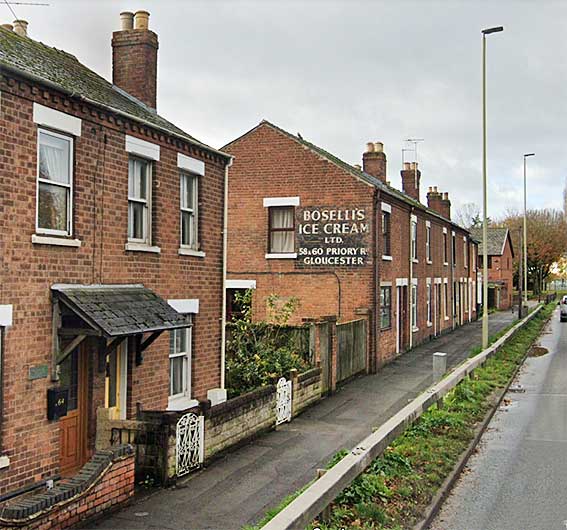 2020 images
2020 images
‘BOSELLI’S
ICE CREAM
LTD.
58 & 60 PRIORY RD.
GLOUCESTER’
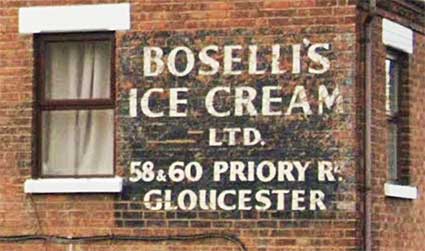 Ice cream manufacture and sale in Britain was greatly associated
with Italian immigrant makers (for example, Gatti, Carpigiani, Rossi
and, in
Gloucester, Tartaglia). Swiss émigré Carlo Gatti set up the first
gelato stand outside London's Charing Cross station in 1851. The brand
names
had an exotic ring to them. It is probably the reason Mr John Kilyan
who founded this ice cream company in Gloucester, named it after his
wife's family: Maria Kilyan
neé Boselli. The company ceased trading in 1989. Priory Road,
mentioned in the sign, is nearby but it would make sense to advertise
on a main thoroughfare, St Oswalds Road. Presumably the
owners of the house were paid, unless Mr Kilyan was himself the owner,
of course.
Ice cream manufacture and sale in Britain was greatly associated
with Italian immigrant makers (for example, Gatti, Carpigiani, Rossi
and, in
Gloucester, Tartaglia). Swiss émigré Carlo Gatti set up the first
gelato stand outside London's Charing Cross station in 1851. The brand
names
had an exotic ring to them. It is probably the reason Mr John Kilyan
who founded this ice cream company in Gloucester, named it after his
wife's family: Maria Kilyan
neé Boselli. The company ceased trading in 1989. Priory Road,
mentioned in the sign, is nearby but it would make sense to advertise
on a main thoroughfare, St Oswalds Road. Presumably the
owners of the house were paid, unless Mr Kilyan was himself the owner,
of course.
[UPDATE 11.8.2021: 'The
building carrying this sign is actually 58 Priory Road. This
section of Priory Road was incorporated into the new St Oswalds Road in
1933 when it formed part of the northern ring road but the house still
retained the old address. Mystery solved! The company was formed by a
Pole in about 1962 but named after his Italian wife because it sounded
more authentic. It was sold on in 1973 and ceased trading in
1989. Mike Payne Thanks to Mike for
the
information.]
Co-operative shop, 9-11 Stroud
Road
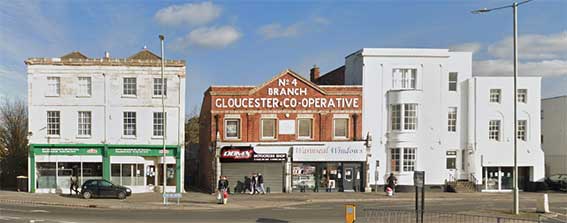
‘NO. 4
BRANCH
GLOUCESTER CO-OPERATIVE
AND
INDUSTRIAL
SOCIETY
LTD.’
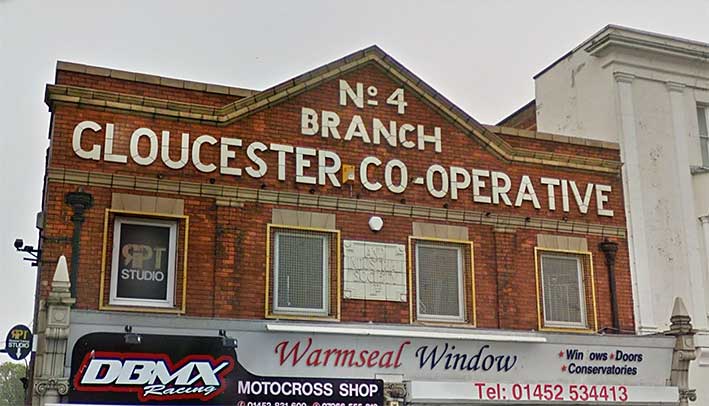
The larger chracters in white are attached to the redbrick wall,
running into a palladian triangle at the top of the facade. They are
composed of jigsaw-like sections, also seen on the 'R&W
Paul' sign on the concrete silo near to Stoke Bridge in Ipswich.
The decorative square tablet below is worthy of attention: the
condensed Roman capitals, with superior 'TD' in Art Deco framing have
great style – all composed of thirteen tiled components.
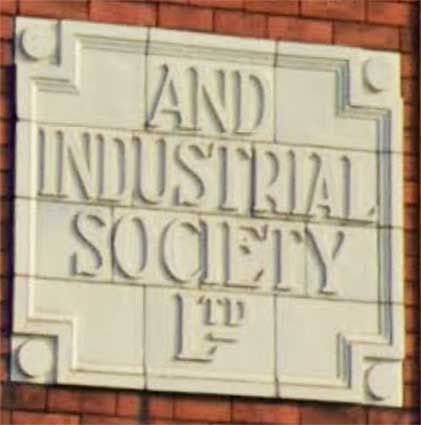
Guildhall, 23 Eastgate
Street
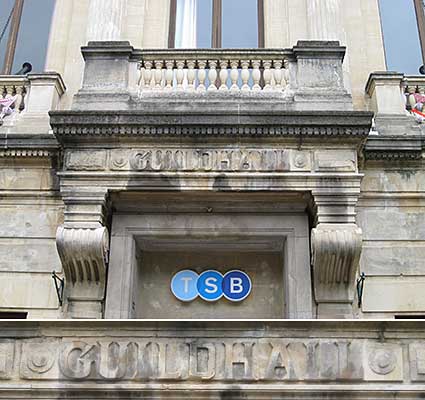
'GUILDHALL'
The Grade II Listed building, which was designed by George H.
Hunt in the French Renaissance style, was completed in 1892.
There'sa lot more lettering to find in the city; in fact, there's book
full of them: Fading ads of Gloucester by
Chris West, published by History Press, 2014.


 2013 images
2013 images
















































 2020 images
2020 images




